What Do The Belts Decorated With Crocodile Emblems Worn By The Two Kneeling Figures Symbolize?
A Study of Stone Carvings with some Comparison of Corresponding Features on Pottery and Jades
I
ALTHOUGH the monuments of the Maya Quondam Empire — monolithic stelae and altars, stone and wooden lintels—are few in number and often badly worn, they are the fullest record we accept of the wearing apparel of the people who raised them, for we accept too niggling data on the provenance of almost carved jade plaques, painted pottery, and terra cotta figurines to utilise them as primary show. The monuments show us the elements of costume found everywhere so combined in different cities as to give each site a distinct individuality. The irreducible minimum of Maya garb was headdress, cervix ornamentation and girdle or loin textile [Figure 1]. These, in one form or other, are universal; additional capes, skirts, sandals, leg and arm bands appear sporadically.
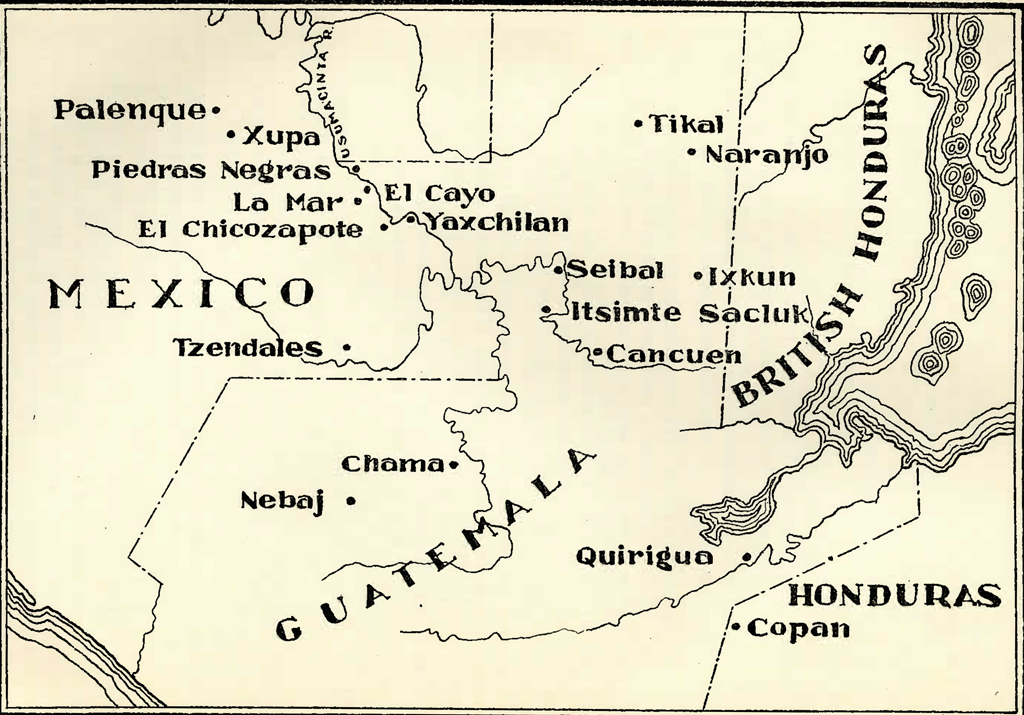
HEADDRESS. The early Maya seem, like their later brothers, to have worn their hair long. Monuments from every southern site show figures, who, lacking more formal headdress, have their hair pulled up to the crown of the head, bound by ribbons or strips of textile, and then allowed to hang or bladder at volition, an inexpensive substitute for the feathers used on all forms of headgear [Figure ii]. Sometimes beads were strung separately or in groups along these locks of hair, sometimes feathers or flowers were mingled in the culminating tuft or in the binding, sometimes snake skin was used for binding or a bandeau. Some of the headdresses at Palenque and Yaxchilan are elaborations of this handling, while others show the hair tied at the dorsum of the neck. Well-nigh every figure, even so, on reliefs, jades or pottery, boasts a more or less elaborate example of i of the two main forms of headgear — turbans and mask headdresses.
Cloth turbans have iii forms: the horizontally folded, the vertically folded, and the round. The offset, plant at Copan, is the shape of a truncated, inverted cone [Effigy 3, a]. On its base, the acme of the turban, may stand up another truncated zone, a bird, a crocodile, or formal loops and knots. It is also used on stela B as foundation for a mask headdress, and on stela I has only a very thick base to top it off.
The 2nd form is constitute at Piedras Negras, sometimes with a snake mask on the front, or every bit a base [Figure three, b]. The turban on stela 14 is decked with a decease's head, and that on stela 1 with planetary symbols bounded by frets.
The round turban occurs at Tikal, Copan, Piedras Negras and on the Chamá pottery [Effigy 3, c]. At Copan, it is hidden under a flame-like roll, or appears as a bully hemisphere trimmed with three bows at the sides, and pocket-size grotesque heads at the dorsum and forepart. Stela 35 at Piedras Negras may evidence a round turban as the chief chemical element in the headdress; on stela 9 such a turban serves as foundation for planetary signs and base of operations for an owl's caput; on lintel 4, it bulges, unadorned, above a possible owl's head, and, large and airship-like, is the only one that resembles the turbans on the pottery in its apparent roughly woven surface. The latter are trimmed by an occasional cloth knot, a flower with feeding bird, or a flower and fish.
Various forms of cap are also institute: a definitely pointed fabric i at Yaxchilan [Figure 4, a], and tall cylindrical ones at Piedras Negras. That on stela 12 is topped by what may be an embryo turban, that on lintel two by an entire macaw. The helmets of the row of soldiers on this lintel are probably quilted caps [Figure 4, b]. At El Chicozapote, a tall cylinder tufted with feathers rests on top of the head [Figure 4, c], and the priest on the Palenque sanctuary tablets has a wide band wrapped or tied well-nigh his caput into the same shape, while the worshipper wears a cap with iv flaps falling from the top [Effigy iv, d].
Mask headdresses probably derive from those which bear witness the wearer's face framed in the jaws of a ophidian, thus imitating the deities, who, on monuments and codices, project whole or in sections from the mouths of serpents or mythical monsters [Figure 5, a]. An apparent sequence in this type of headdress tin can be traced in the dated monuments that show it. A lintel from Temple III at Tikal, dated A. D. 228 according to the Spinden-Morley correlation, used in this paper, shows the wearer's face between complete upper and lower jaws [Effigy five, b]. On stelae P, ii and I at Copan, dated A. D. 363, 388, 407 respectively, and the undated stelae ane and 2 at Tikal and the figure on the due west side of the doorway in the Temple of the Cross at Palenque, the lower jaw has become a mentum strap with a grotesque mask in the centre [Effigy 5, c]; the latest of those dated, however, is the almost realistic. At Piedras Negras, stelae 26, 31 and 7, dated A. D. 368, 378, 405, respectively, show another line of development of the lower jaw highly conventionalized [Figure 5, d], of which the beardlike bagginess on the faces on stelae B and F at Copan, dated A. D. 471 and 523, may be a degeneration [Figure 5, e]. A chain hanging to the breast, at Tikal, and two chains terminating in serpents' heads at Copan and Quirigua may be survivals of this thought, though this last ornament is found equally a chain hung over the tree on a Palenque tablet. Headdresses, showing the front view of the upper jaw of a reptile snout, merely defective the lower jaw, appear at Copan and Piedras Negras, and on jade plaques [Effigy 5, d]; such a serpent snout is shown on a shield at Cankuen. These may be the same headdress that is shown in contour at Naranjo, Copan, Yaxchilan, Quirigua, Palenque, Tikal and Ixkun: diverse masks, lacking the lower jaw, of God Thou or his serpent proto-blazon [Figure 5, c]. Animal masks, as well, sometimes crocodile, sometimes jaguar, are frequently the main element in a headdress, and even a death'south caput is occasionally used. A variation is the headgear in which, over pilus or head roofing, is fastened, at the bending of a visor, a band decorated in front with a grotesque or reptilian head [Figure 6, a].
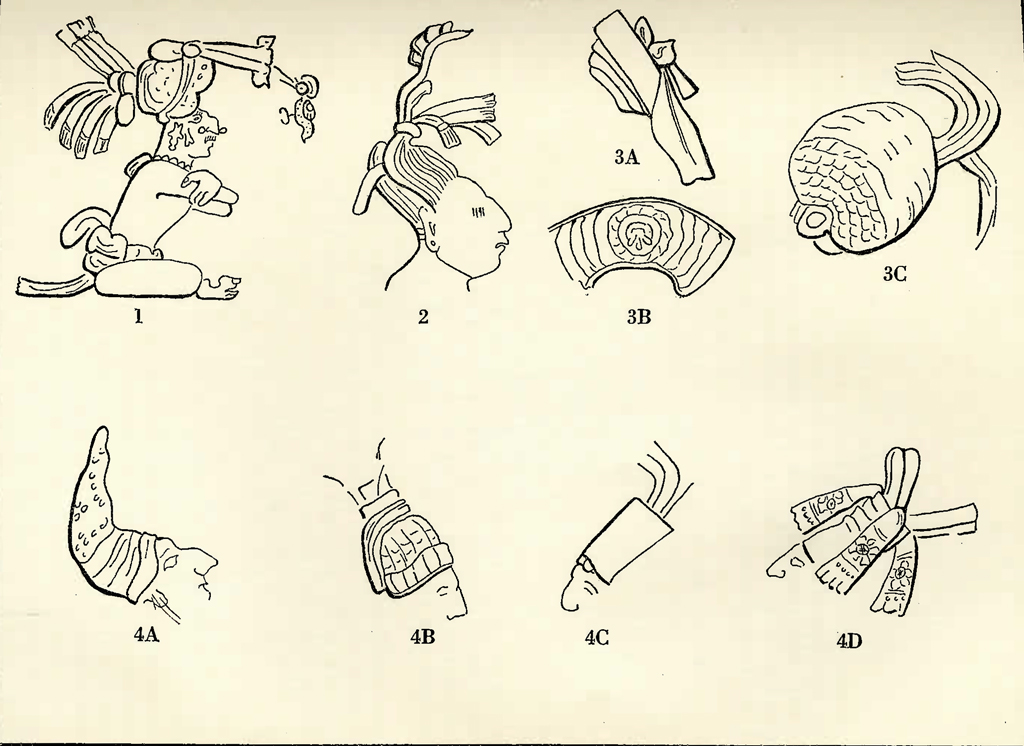
There are, of grade, headdresses that do not fall into these two main classifications, such as a broad-brimmed hat, seen at Tikal, that is much the shape of the harbinger ones worn past the Indians of the Northwest coast, and is decorated with the crossed bones plant at Piedras Negras, Chichen Itza, and on the cloak of the Bat God on a Guatemala vase [Figure 6, b]. A headdress of a crown of feathers surmounted past a large bird's head is worn by God D at Palenque, and by God N on a vase in the Academy Museum. Then there are headdresses at Copan, Piedras Negras and Yaxchilan that are difficult to allocate except as braided or woven structures; several of these at Yaxchilan are characterized by stretches of striped or folded textile that may exist derived from the turban [Figure 6, c]. Hither, also, and at Cankuen and Piedras Negras, the serpent's tail, curled, is used as a base for construction [Figure 27].
For about all these headdresses have a bang-up deal of additional ornament; none, for example, is without features at pinnacle, sides or back; some, in fact, are composed of footling else. The snake, or some portion of his anatomy is the most prevalent decorative element: used entire at Copan, Piedras Negras and Seibal; half emerged from the elevation of the headgear at Yaxchilan, Naranjo and Palenque; one or more tails at Piedras Negras, Yaxchilan and Cankuen; an upper jaw at Copan; and a miniature sort of Ceremonial Bar at Piedras Negras. Additional heads or masks, human, grotesque, animal or reptile, are found in some course or size on headdresses at every site except Naranjo. Three superimposed circular chaplet beneath an inverted bong-shaped one [Effigy 6, a], unremarkably serving every bit base of operations for a burst of feathers, appear on summit of headdresses at Tikal, Quirigua, Piedras Negras, Yaxchilan, Naranjo and Seibal. At Yaxchilan long neckbeads and an abbreviated openwork spear are sewn vertically at the sides [Figure half-dozen, c]. A stela at Piedras Negras and a lintel from Tikal have fabric rosettes in front and a sort of hinged elbow projecting from the rear [Figure 7]. Signs and symbols are fairly frequent; probable planetary ones at Copan, Tikal, Quirigua, Yaxchilan, Piedras Negras, Palenque; a hand, palm out, at Copan, Piedras Negras, Seibal, Palenque; a fish feeding from a flower at Copan, Ixkun, Palenque, on pottery from Chajcar and Nebaj, and in borders at Palenque and the Chichen Itza ball court ; a blossom at Yaxchilan and Palenque; a fish at Piedras Negras; a bird feeding from a flower on a Chamá vase; a heron with a fish in its bill at Palenque and Seibal; a bird at Piedras Negras, Seibal and Copan. What Spinden refers to as a cruller-shaped symbol probably belonging to the sunday god [Figure 8, a] is found over the nose of figures at Tikal, Seibal, Naranjo; on the head on the girdle of a Copan stela; and on that of shields carried at Tikal, Ixkun, Naranjo, Itsimte Sacluk and on the Gann jade plaque; and what he calls the symbol of the back, underworld head of the Two-Headed Dragon [Figure viii, b] occurs at Copan, Piedras Negras, Yaxchilan, Palenque; at the terminal-named site on an object held, as well every bit on a headdress. A fret curling upward from the olfactory organ of a effigy, in 2 instances at Yaxchilan [Figure viii, c], is exactly like that on the Gann plaque, proving that the latter is not a degenerate Toltec speech scroll but a purely Mayan symbol.
NECKLACES. These were practically universal, long and brusque, usually of circular beads, but sometimes, as at Copan, of round and cylindrical beads combined. These beads were probably jadeite, every bit most of the rock beads found and so far have been made of this cloth. Some of these necklaces at Copan, Yaxchilan, Piedras Negras and Palenque take down the wearer'south back an additional string ending in a tassel [Figures 1 and 26]. An amulet of a human face edged with small circular beads [Figure ix, a] appears in the front of such strings of beads at Copan, Quirigua, Yaxchilan, Piedras Negras, Tsendales, Palenque, and fifty-fifty at Chichen Itza in the New Empire; usually three pendants, each of a long and a round dewdrop, hang from the amulet, and iii projection from each side. At Piedras Negras a personage wears an amulet of an entire human figure. A long tubular bead, with similar rays at each finish, suspended from thongs or material strips [Figure 9, b], was worn at Copan, Quirigua, Yaxchilan, Piedras Negras, Seibal, and is seen on jades and on the pottery; a possible development from it, or else degenerate conventionalization of the Formalism Bar (encounter Copan, stela 11; Quirigua, stela C) is a apartment, oval bar, with trefoil projections at the ends [Figure ix, c], establish at Tikal, Quirigua, Piedras Negras, Yaxchilan and Naranjo. An oblong bar, similarly suspended [Effigy ix, dl, is establish at Copan, Tikal, Naranjo, Cankuen, on stone figures from Copan in the Peabody Museum, and on the Chamá pottery; and an apparently inflexible carved necklace, associated by Seler with the Expiry God, appears at Copan, Quirigua, Naranjo, Seibal, and on the Bat God of the Guatemala pottery [Figure ix, east]; here the girdle is similar. A necklace of leaves on a narrow ring is worn short at Piedras Negras and long at Naranjo [Figure 9, f]; at Palenque and Tikal an ornament of woven ribbons or textile strips hangs at the level of the wearer'southward waist [Effigy ix, one thousand] ; at Palenque, an elaboration of the long dewdrop hangs from a knee-length intricately carved concatenation; at Yaxchilan, on the pottery, and on a jade slice besides equally on a painted vase two big oval objects, probably beads, are held tight at the neck by a thong [Figure 9, h].
Circular collars [Effigy 10], sometimes long enough to exist called capes, made sometimes of circular beads, sometimes of circular and cylindrical combined, but usually of close set squares that are perhaps jadeite, appear everywhere. The long dewdrop described above is worn with them, superimposed or suspended, as is the flat, oval bar, itself sometimes of similar squares. Amulets are often sewn on the collars, and at Copan, Tikal, Yaxchilan, Piedras Negras, Seibal, Ixkun, Cankuen, and on jade plaques, are visible in threes, one in the heart and one on each shoulder.
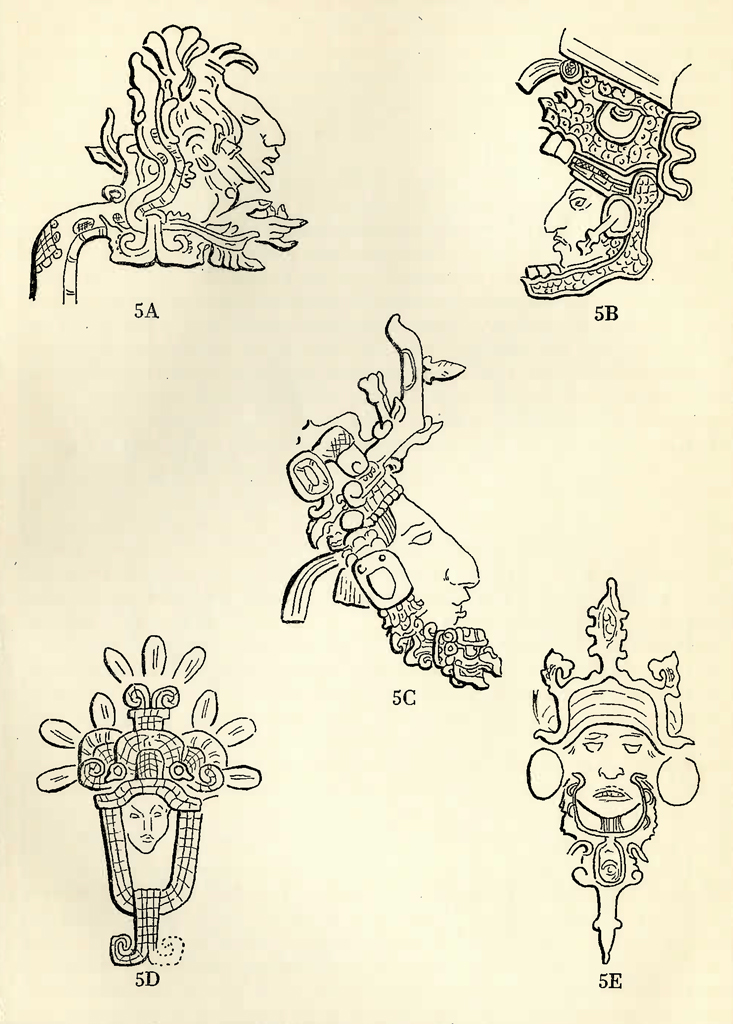
At Yaxchilan lone is establish a sort of muffler [Figure xi], of tubular material, feather or textile, that hangs about the cervix like a scarf and is knotted at the level of the waist; a similar neck ornament is seen on a figurine in the Peabody Museum, and on the pottery a brusk section of the same textile is attached to strings that tie at the dorsum of the neck, the puffy crescent thus formed in front being sometimes trimmed with knots and joined with an ellipsoidal bar. At Chichen Itza a Maya chief is property, presumably equally an offer, a bunch of these same long, tubular affairs, knotted at either end.
GIRDLE. A type of girdle plant at all of these sites but Quirigua and Piedras Negras may be taken as the norm: adequately wide, by and large of cloth in a design which may have planetary significance, with a fringe of ocean shells, it has in the front and at the sides large amulet heads with iii shells hanging from each [Effigy 12]. Variations may lack the side heads, may have the solitary head that of a jaguar, or may lack only the cardinal head; over again, girdles of varying design may be entirely without such heads. A strange, corsetted effect is produced by a girdle several inches wider than the tightly spring waist at Quirigua, Piedras Negras, Yaxchilan, Naranjo and Seibal [Figure 13, a]. A unlike type of girdle that appears almost oftentimes at Palenque and is always associated with a long or short network skirt consists of long tubular beads, set up vertically close together and edged at the bottom with circular chaplet [Figure 13, b].
The long flap hanging from the front of the girdle that Spinden calls apron, may vest to the girdle or the loin material underneath it. Its about elaborate form, boasting one or more grotesque faces, with frets at the sides [Figure xiv, a], appears at every site; lacking grotesques, at Copan, Quirigua, Ixkun and Yaxchilan. In other forms, it is unmistakably textile at Piedras Negras and Naranjo [Figure 14, b]; probably textile, decorated with beads carved into rosettes, at Yaxchilan, Palenque, and on jades [Figure xiv, a]; and substantially bead at Copan, Tikal, Naranjo, Yaxchilan and Palenque [Effigy 14, d]. At this site like dewdrop ornaments hang from the back of the girdle, sometimes shorter ones from the sides, and ii carved bondage from a man's chugalug back up a grotesque manikin swinging behind him. This occurs also at Tikal, where a grotesque head may be similarly hung from a seated figure on a lintel.
LOIN Material. The traditional Maya loin material, that wrapped around the waist in a wide band with long ends before and behind, is shown on the pottery; a variety with front flaps and a shaped skirt [Figure xv, a], shown at La Mar, must accept been worn under girdles and tunics, for we have skirts that undoubtedly belong to such garments, of textile at Yaxchilan and Piedras Negras, of network at Tikal, Piedras Negras and Palenque, of jaguar peel at almost every urban center. A loin cloth that wraps around with a long triangular apron front appears at Palenque, Piedras Negras and Yaxchilan [Figure 15, b].
SKIRTS, ROBES. Long skirts of the network that seems to be diagonally woven of circular and cylindrical chaplet [Figure 16] are found alone at Copan and Palenque, over textile at Naranjo, and over jaguar skin on stela H at Copan. At Naranjo a long textile skirt is worn nether a long feather greatcoat; at Cankuen under an credible network wearing apparel, much like the network garment covering a true cat-faced figurine from Chamá. At Tikal, Piedras Negras and Yaxchilan elaborate robes, probably embroidered, are attached over the shoulders [Figure 26].
CAPES. Short capes are of network at Copan, Palenque and possibly Naranjo, of peel at Tikal and Yaxchilan. Plumage capes are long in front at Naranjo and Piedras Negras, long behind at Tikal, patently but over the shoulders at Copan, Piedras Negras and Naranjo [Figure 24, b]. At Yax-chilan and on two figurines in the University Museum occurs a cape, long backside, that may be feathered, quilted, or plain material, and on a Copan stone figure in the Peabody Museum, in that location is a short, richly embroidered fabric one.
Tunics, probably of the same close ready squares of which collars were made, are worn at Piedras Negras and Yaxchilan; one of jaguar skin at Yaxchilan, and here as well a woven diversity with bead rosettes.
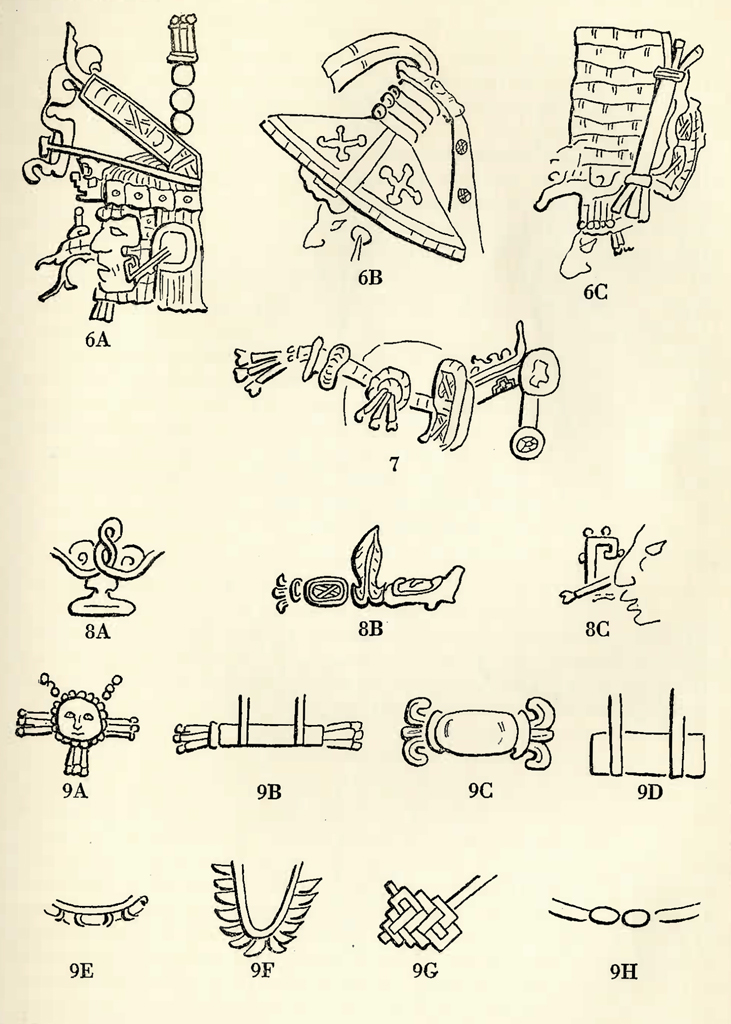
ACCOUTREMENTS. Almost every sculptured figure carries some object of practical use or religious significance. Military implements are adequately common; the spear appears in every city but Copan and Quirigua; a curt ane, resembling a javelin, is plant at Naranjo, and the man on stela 2 at Cankuen carries a bunch of brusque javelins like those used with the atlatl. Formalism types include an openwork variety found besides at Chichen Itza, every bit well as at Tikal, Naranjo and Itsimte Sacluk [Effigy 17, a]; varying snake head kinds and one that ends in a hook, at Piedras Negras [Figure 17, b]; and long staves at Naranjo, Ixkun and Tikal. Shields, worn on the left forearm, are round and small, representing normally a human or grotesque confront at Tikal, Quirigua, Ixkun, Itsimte Sacluk, Yaxchilan, Naranjo and on the jade plaques; larger and oblong at Piedras Negras, Naranjo and Tin-kuen, and on a figurine from the Highlands of Guatemala. On a Chamá vase a large oblong shield stands behind the primary, and at Palenque a big round one stands earlier 2 crossed formalism spears. At Tikal, Yaxchilan and Tsendales, human or death's heads are slung presumably as shields at men'due south backs; the reverse of stela H at Copan shows what may well be intended for the same matter. At Yaxchilan we find a stone knife on lintel 26, jaguar claw clubs on lintel half dozen and a feathered society on the deity side of stela 11.
Figures carry small numberless or pouches of varying shapes and stuffs at Piedras Negras, Yaxchilan, Tsendales, Naranjo, Seibal, Palenque and Tikal; a foliated one on stela 30 at Naranjo [Figure 18, a] is duplicated in that carried past a Toltec at Chichen Itza; and an object of the same shape on a vase may be bag or fan. An axe with trefoil edge [Effigy eighteen, b] occurs at Yaxchilan and Palenque; stave-like torches decorated with a Maltese cross at Yaxchilan; curt cone-similar torches at Yaxchilan and possibly on the pottery, and what may be torch or foliated stave at Yaxchilan on lintel 24; a round fan, long-handled and feather-edged at Yaxchilan, short-handled at Naranjo, and woven or braided on the pottery. A strange object is one made possibly of feathers, perhaps of scales, carried in the hand on stela thirteen at Naranjo and on a vase, and worn apparently suspended from the headgear on lintels 6 and 43 at Yaxchilan [Figure 18, c].
Religious importance is attributed to the Ceremonial Bar and the Mani-kin Scepter. The first, a short bar with a human head between the ophidian jaws [Figure xix], is found at Quirigua and Copan, the ophidian body a pendant curve on the three earliest stelae at the latter site. At Tikal, an entire figure rests in the serpent's oral cavity. The bar is short without homo heads in 2 Quirigua stelae; long and decorated with planetary signs at Seibal; the same, with masks in the serpents' jaws, on stela 4 at Yaxchilan, and long with homo heads simply no symbols on the bar on stela 1, and at Naranjo. The second, in its usual form of the Manikin God held by his snake leg [Figure 20, a], occurs at Tikal, Quirigua, Itsimte Sacluk and Yaxchilan; at the last-named site the same god appears seated on a braided truncated cone that is mounted on a long staff [Figure 20, b], and information technology is probably he who, seated or reclining on a absorber, is held aloft on the sanctuary talets at Palenque. Hither, at Tsendales and Piedras Negras, is constitute the form of the Manikin Scepter that is reduced to a head on a staff [Figure 20, c]; the kid in arms at Palenque who has one leg a snake'southward body and caput may be some other manifestation of the same deity. A blazon of flexible shield, probably representing water [Figure 21] (see Dresden Codex), seems to be an object of adoration at Yaxchilan, is held, in abbreviated form, past a worshipper and worn in a headdress at Palenque; and hangs from the jaws of the Ceremonial Bar snakes at Quirigua. A conventionalized tree with a bird at the top [Figure 22] is carried at Yaxchilan, a tree not so conventionalized on a jade plaque. A basket appears generally equally an adjunct of the thorn-knotted penitential rope at Yaxchilan, merely seemingly secular in its use at Naranjo and on the pottery; a modest tied package is borne by minor figures at Yaxchilan; a feathered jaguar head is being presented to the possible god on lintel 26 at that city; and on a Chamá vase two men carry bones painted cerise on one end. A snake is held vertically past the figure on a Quirigua incense-burner and past both persons on a Palenque relief; a snake with a god issuing from his jaws appears first betwixt two men, on Yaxchilan lintels, its body held by the man on the left, then, unsupported, to a solitary worshipper.
A mask is worn over the face of the master effigy on monuments at Copan, Tikal, Yaxchilan and Palenque; the object carried by the human on stela viii at Seibal may be such a mask, and the scale system close-plumbing equipment most the face on stela 11 at the same city [Figure vi, a] may be a degeneration or an impressionistic rendering of one. Small figures that may be related to those in the panel glyphs at Quirigua play about in the intricacies of the Copan and Quirigua headdresses [Figures 24, a and 25] and hover over the demolished head on lintel five at Piedras Negras.
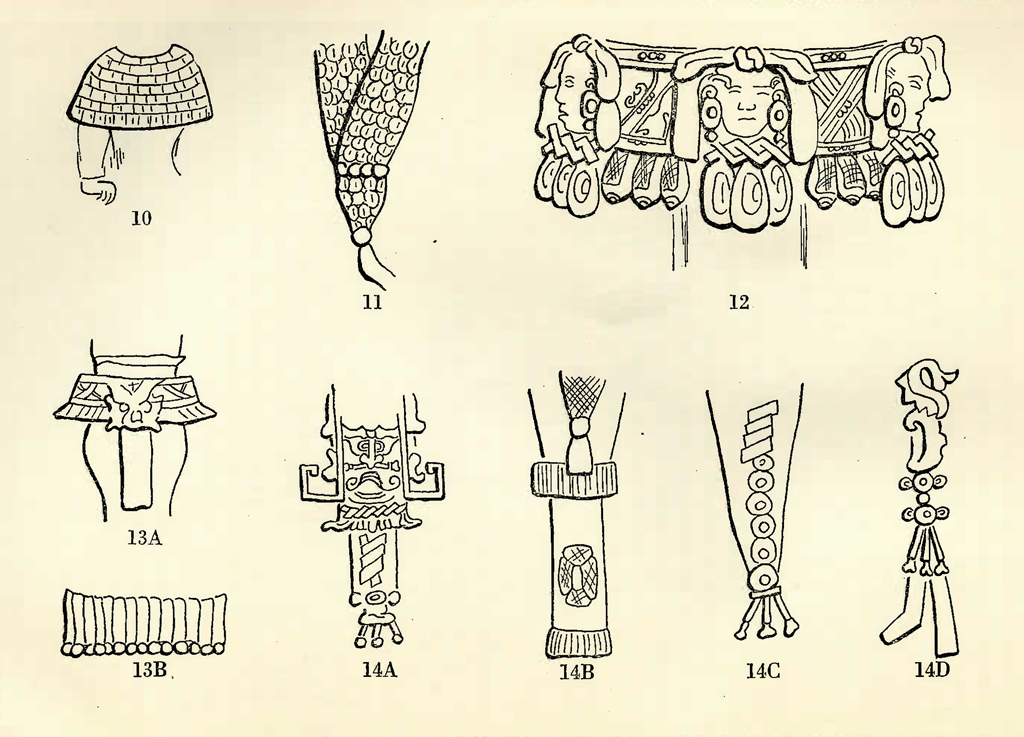
Two
In spite of this full general distribution of manufactures of apparel, there are costumes at each site typical of that city, and sure objects non withal found elsewhere.
TIKAL. Men at Tikal wear a snake mask headdress, neckband with foliated bar, and a shell-fringed three-headed girdle over a skin or net skirt [Effigy 23]. This is the only place where we notice a headdress showing the wearer'south head between the realistic jaws of a scale ophidian [Figure 5, b]; where the openwork spear is held horizontally or aslant across the body; and where an entire figure rests in the jaws of Ceremonial Bar snakes.
COPAN. At Copan there are 2 singled-out divisions, the standing figures of the stelae [Figure 24, a] and those seated in rows well-nigh the altars and along the step constitute by Maudslay [Figure 24, b]. The men on the stelae habiliment towering headdresses, with tiny figures, sometimes animal-headed, popping in and out of the folds; shell-fringed three-headed girdles that hither lonely have straps — plain, knotted or grotesque hanging between the heads; sandals and cuffs that are adaptations of a snake'due south head; square-fix collars that are half-subconscious by the Ceremonial Confined they bear. Simply at Copan do we find this commodity with the bar replaced by a realistic snake trunk. Stela North seems to stand for a water, presumably crocodile, deity; stela I shows a man in a mask (probably the face of God D, portrayed in the heads on his girdle) carrying a dead snake, with the three-member underworld symbol at the top of his headdress. On 2 stelae occurs the horizontally folded turban which is such a marked characteristic of the seated figures.
This turban appears on 30-half-dozen of the twoscore-ii figures on altars and stride; two of the remaining six wearable a round turban with the ringlet front that is found nowhere else. The rest of their costume consists of the traditional grade of loin cloth, and cervix ornaments of the horizontal long dewdrop — hung singly, in pairs, or three together — or two snakes, from whose knotted heads hangs a bead-fringed tau-shaped decoration that sometimes develops into a jaguar head; almost all wear short feather shoulder capes.
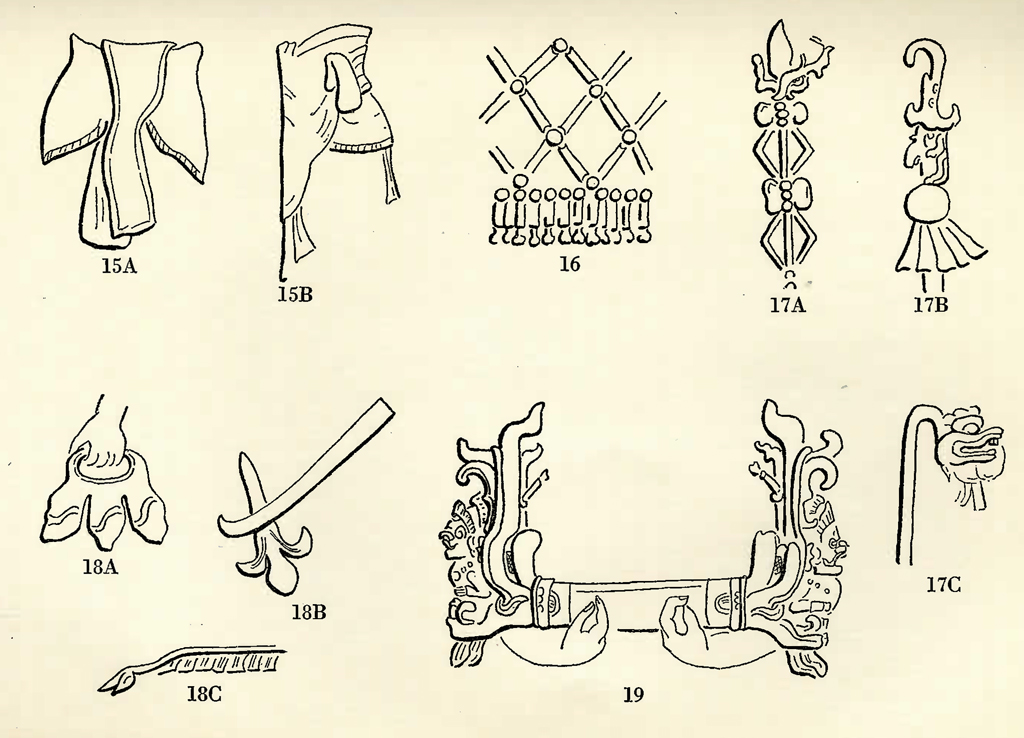
QUIRIGUA. The typical Quirigua costume [Figure 25] would be a high headdress of superimposed masks; a collar with 3 amulets or a scale foliated bar, the latter found where a Manikin Scepter is carried; a vanquish-fringed girdle with 1 cardinal head and grotesque, fretted frock; bead human knee bands with an amulet in front, and sandals with a grotesque face. A Ceremonial Bar is found here with water pouring from the snakes' mouths. On the n sides of stelae A and C, that is, the side toward the mound before which they stand, are symbolical or masked dancing figures, with the head in profile, and with highly conventionalized girdle, headdress and Ceremonial Bar.
PIEDRAS NEGRAS. Only at Piedras Negras do nosotros have definitely militaristic scenes. Lintels 2 and 4 both testify a captain facing a file of soldiers; and stela 12 shows captives, guarded by soldiers, beingness presented to a chieftain past a presumable priest. Also at this city is a unique series of stelae that show persons of great importance seated in canopied niches. A homo with a serpent-snout headdress, with or without the geometrically conventionalized lower jaw, or in a vertically folded turban, wearing a collar and loin cloth with elaborate textile flap, or wrapped in a robe, would be characteristic of this site [Effigy 26], as would one in a girdle of shut fix squares fringed with rows of shells, beads and peradventure embroidery, with brim or loin cloth showing beneath, wearing embroidered knee bands, a neckband of alternating round and cylindrical chaplet, a plumage holder erect or on its side somewhere in his headdress, and carrying an ellipsoidal shield and a spear practical or ceremonial. Only here on the monuments do nosotros run across shepherd's crooks catastrophe in a ophidian'due south caput [Figure 17, c], and spear ends where a conventionalized snake god's head becomes a sort of gunkhole claw [Figure 17, b]. The coincidence of crook and headdress with lower jaw on stelae 26 and 31 makes one feel that they stand for the same person. The main warrior on lintel 2 and the figure on lintel 35 too strongly resemble each other, having identical collars, with an unusual edge decoration, identical shields, bags, and textile aprons decorated with a four-petalled flower, and similar headdresses and girdles. These identical costumes on different monuments are in both cases dated within a few years of each other, which may indicate actual portraiture.
YAXCHILAN. At Yaxchilan the atmosphere seems to be almost exclusively religious; practically every etching shows a person receiving or holding ceremonial objects. Characteristic of this urban center are figures in reptile headdresses that seem more apt to represent the snake god M than an actual snake, for the eye is almost ever to a higher place the nose rather than backside it. They clothing foursquare-set knee bands, collars and long robes; or collars with iii amulets, accompanied by elaborate headdress and varying girdles [Effigy 27]. A characteristic girdle fits tight at the waist and flares below; 1 portion or the other is generally decorated with beads or the ubiquitous shut-fix square. Unique here are the bird and tree object [Figure 22]; the penitential rope; big stave-like torches decorated with Maltese crosses [Figure 27], and small cornucopia ones; and various elaborations of headgear such as the geometricized snakes of lintels 8 and 24, the striated textile headdresses referred to above, and applied long chaplet, openwork spears, and small superimposed shields. A tunic with rosettes probably of chaplet, is found merely here, and with it there is always the muffler [Figure 11], that mysterious neck adornment peculiar to Yaxchilan. Twice, the man who wears them carries a flexible shield, in one case, a knife; where he wears a muffler but no tunic he holds a spear, and, on lintel 45, a spear and flexible shield. Just at this site practice nosotros have a snake appearing with a god issuing from his jaws. In that location are at Yaxchilan iii cases of near complete identity between figures on unlike lintels. The first, lintels 6 and 43, shows the main figure on each relief wearing an creature mask headdress with long beads attached vertically at the sides, a collar with iii amulets and pendant long bead, a tied girdle with a jaguar head in front end, what seems a bordered tunic but may be upper arm and thigh bands, elaborate amulet knee bands and sandals. They accept olfactory organ plugs that turn up with a flare at one cease; a strange feather or scale mentum strap, or pendant from the headdress, and carry the beehive blazon of Manikin Scepter. In the 2nd instance, lintels 1 and 42 show the principal figure — on one lintel turned away from the lesser, on the other turned toward him — wearing a striped or folded textile headdress with 2 superimposed modest shields and a long bead at the side, a collar with iii amulets and pendant bead with a semi-circular flap hanging from it, a flaring girdle with tabs beneath it, scale human knee bands, sandals, holding in the right hand a Manikin Scepter, on the left wrist a round shield. In the third case, lintels iii and 7, both figures have headdresses of a curled snake tail surmounted past 3 chaplet and two more tails, crush-fringed girdles with three heads, fretted aprons, a circular shield on the left wrist and a Manikin Scepter in the correct hand. Here, as at Piedras Negras, identical costumes are dated shut together. The fragments of stelae ane, iv and 6 also bear a strong resemblance to each other: at the top, we come across sunday and moon glyphs on either side of a mask; below, a figure with a human head slung at his back wearing a collar with three amulets, a girdle without heads, and a bead frock, holds a flexible shield [Figure 21] over a knotted and woven object that may exist pulsate, altar or table. Offerings are laid on a similar object in a secular scene on a Chamá vase.
NARANJO. Characteristic of Naranjo is a effigy in a serpent or snake god headdress and a long net-over-textile skirt, carrying a filled basket [Figure 28], or else i rather like Tikal only holding aslant a long Ceremonial Bar with human heads in the snake jaws.
SEIBAL. A man wearing a collar with iii suspended amulets or one made of beads in a zigzag pattern, a girdle of planetary symbols with heads at the sides, and a grotesque apron with rounded frets over a brusque skin skirt, whose chemical compound visor type of headdress is built over a helmet probably of false pilus, and who carries cater-corner a Ceremonial Bar, long and decorated with planetary signs, would be from Seibal [Figure 29]. A bib-like collar, i with a foreign foliated front ornament, and a radiating beaded one, are peculiar to Seibal equally is the prolonged neck bar on stela 1. Stelae 5 and 7 wear the skirted loin cloth every bit at La Mar, and a large, twisted bar, broken at 1 stop, apparently glued to their chests.
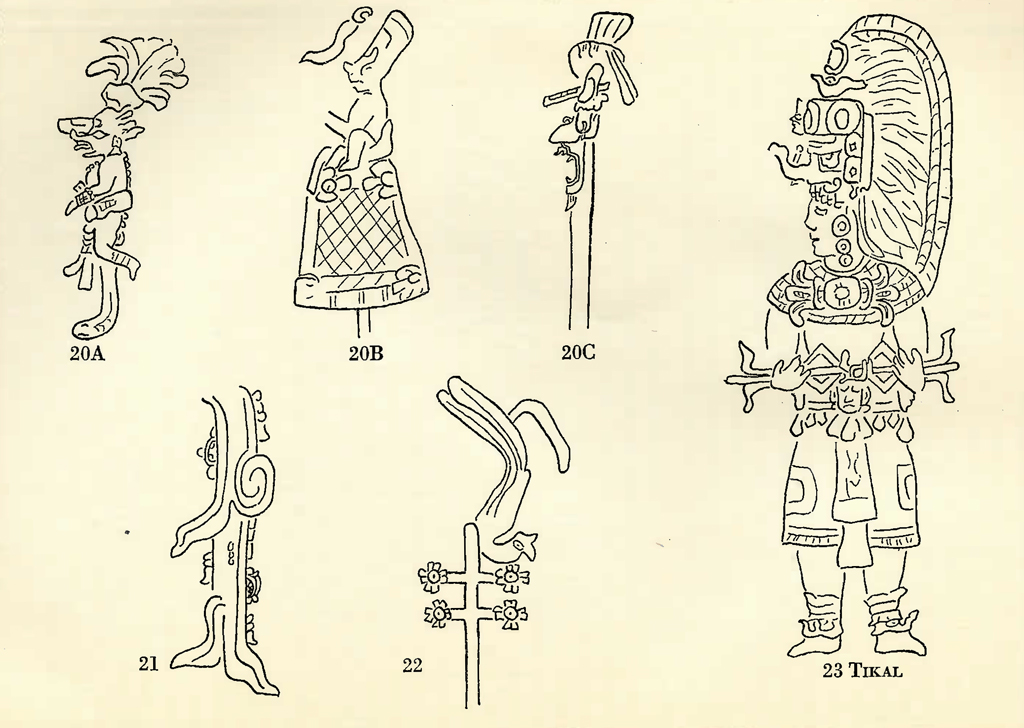
PALENQUE. The characteristic apparel of Palenque [Effigy 30] would be a curt or long net skirt and a net cape, a girdle of long tubular chaplet edged with round ones, hair fatigued upwards and banded with or without supplementary trimming. The costumes on the sanctuary tablets are unique: alpine cap, bead necklace and frock or shaped net loin cloth for the priest; for the worshipper, a cap with embroidered flaps, and a cloth garment that covers him from hips to neck, whence it falls in a twisted rope down his back. Here, in the (ceremonial) spears on the console of the Temple of the Sun, is a new variety whose point is an enlarged and decorated tooth of the ubiquitous God K. Hither also nosotros make definite contact with the gods of the codices. God D, the Roman-Nosed God, probably Itzamna, appears on the east side of the sanctuary entrance in the Temple of the Cross in a costume — a jaguar pare cloak, a textile strip neck decoration, with a padlock-shaped pendant hanging from it, and a headdress in which the caput of the Moan bird is the predominating element — practically identical with that which he wears while supporting the left side of the chantry on the sanctuary tablet of the Temple of the Sunday. At the correct side of this altar, nevertheless, his attributes are essentially reptilian; the neck ornament is the aforementioned, but the headdress is a snake head one, and the god wears a dorsal strip with cross-hatchings.
Three. Conclusions
Although scarcity of material makes generalization dangerous, scenes on the pottery, clearly those of daily life, that show fifty-fifty nobles wearing only headdress, necklace and loin textile, emphasize the ceremonial graphic symbol of the habiliment on the stone reliefs. The quasi-sacred nature of such costumes may account for the plainly static fashions during a catamenia of four hundred years, as witness the clerical robes of to-day. The variations in costume, therefore, are local rather than chronological. Hence, the appearance in only ii or 3 places of articles of costume which are neither confined to one site nor yet widely distributed, shows a mayhap significant contact between cities where there is as notwithstanding no other proof of close interrelation.
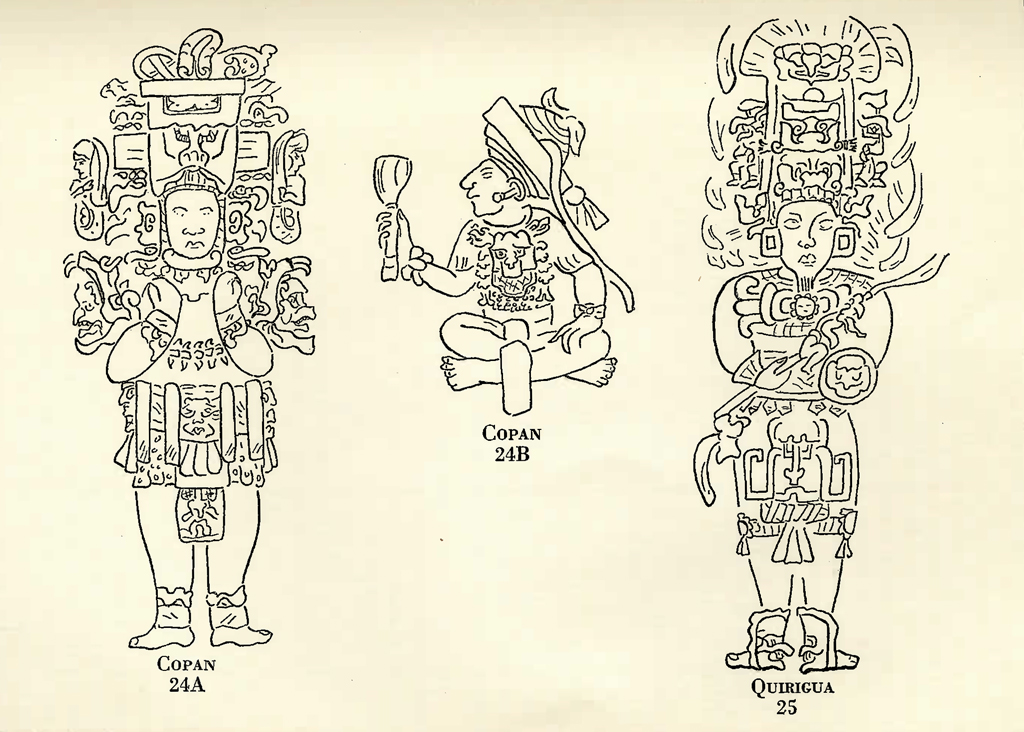
The network article of clothing that makes the feature costume of Palenque [Figure 30] so distinctive is not limited to that metropolis alone, for capes, long skirts, and short skirts appear plain or over a peel or fabric foundation at Tikal, Naranjo, Xupa, Piedras Negras and Copan, while a figurine from Chamá, and a stela from Cankuen bear witness what seem to be complete dresses of this material. Always, however, except at Xupá, a small town non far south of Palenque, and at Copan, the employ of network is, according to our evidence, an adaptation, not a duplication of the Palenque way, for it takes forms not plant at Palenque, and omits the typical combination of long skirt and greatcoat with a long bead girdle. At Copan this occurs twice, on monuments probably erected within a year of each other; stela H, strikingly different from all the other stelae, and altar T, where the persons wearing this costume seem to be in the retinue of two men in a costume more than characteristic of Copan itself. They are interspersed with bird and animal headed creatures and may be taking office in a trip the light fantastic or another religious rite. The cat-headed figurine from Chamá may similarly exist a masked dancer. These isolated occurrences at Copan, at the beginning of the sixth century, of a costume identical with that characteristic of Palenque would seem to prove that the latter was a flourishing city with far-flung relations of trade or war past A. D. 523. It is interesting to note in this connection a figurine, in the Peabody Museum, of a adult female in a blouse of similar openwork diagonal weave, simply patently cotton, resembling in fact Sahagun's clarification of cotton fiber wear worn by the sixteenth century Mexicans.
Palenque and Tikal share two unique adornments: the manikin effigy swinging behind a sculptured personage by bondage from the side of his girdle, and the cervix decoration of woven fabric strips [Figure 9, 1000]. The latter is an object interesting in its connotations. On Chamá pottery this occurs equally a design on a necklace, and it is repeatedly used as decorative detail in costume in the carvings of Copan, Palenque and Quirigua. In the codices it occurs as a mat, from which Dieseldorff calls it the Pop motive from the Maya name for mat. If there were any basis for this connection, one would expect to detect the braided motive in the glyph for the month called Pop; and here it indeed occurs, in the course of the glyph used on the monuments — its only occurrence amongst the glyphs. The Maya title for prince was Ahpop — hence this symbol would seem to indicate authority and princely position wherever it appears. The stela at Tikal on which it is worn as a necklace is early A. D. 215, according to Spinden'south correlation — and one would like to think that, since the necklaces at Palenque are its simply other appearance in this class, in that location must be some close connection between them. The question, nevertheless, of the age of the Palenque temples is as all the same unsettled. The dates on them are adequately early, ending in the center of the fifth century, but according to the architectural development of the Guatemala cities, Palenque is the latest and nearly highly developed of all; hence it has been idea that the temples at that place were erected toward the cease of the Old Empire and that the dates recorded refer to events far in the by. Be that equally it may, the Pop neck ornamentation may prove a link between Palenque and the early Empire. An ornament on a Seibal headdress of two interwoven double-headed snakes probably derives from this motive, and is practically identical with the woven snake motive used in Mexican fine art with Tlaloc, Coatlicue and other deities.
Feather garments appear only at Tikal, Copan, Piedras Negras and Naranjo, though a cape of dubious fabric may include Yaxchilan; and embroidered robes only at Tikal, Piedras Negras and Yaxchilan. There is a headdress with rosettes in front and a sort of hinged elbow behind [Figure 7] that occurs merely twice, once at Piedras Negras, A. D. 442, and once at Tikal, A. D. 481. This may mean close contact between these cities, monuments erected to a hero whom they shared, or merely that we know but two examples of a widely distributed form of headgear. In the same mode the resemblance of a lone puff ball turban at Piedras Negras [Figure 3, c] to those on the pottery from Chamá and Nebaj may or may not exist important. The openwork spear [Figure 17, a] is found only at Tikal, Naranjo and It-simte Sacluk, though it reappears at Chichen Itza. Piedras Negras, Yax-chilan and Cankuen show a warrior in a snake tail headdress, and the harness, besides found at Naranjo, that may exist cloth or closely woven chaplet, and includes skirted girdle, possible tunic, and, at the last three sites, tabs hanging from the shoulders and the sides and front end of the girdle. The man at Naranjo holds one javelin just like the three on the Cankuen stela, and has a shield of the same shape though begetting a different design. These javelins are brusque, the just brusk ones on the onetime Empire carvings, and identical with those carried for use with the atlatl by the Toltec warriors on the Chichen Itza Tiger Temple frieze. At that place is, however, no representation of the spear thrower itself, unless it should exist the partly obliterated object in the right hand of the Cankuen warrior.
A new element enters in the identification by costume of deities or historical personages. The cases cited of identical costumes on different monuments seem to show human beings rather than divine, with the exceptions at Yaxchilan of the man holding a flexible shield over a possible chantry on stelae 1, 4, and 6, and the frequent homo-in-a-muffler, whose companion almost always kneels before him. There is no sure inkling as to which gods these are, if gods they be, nor tin can we be certain as to whether they show the god himself or merely a priest in divine regalia. The startled attitude of the worshipper on lintel 16 at Yaxchilan, all the same, might well bespeak his reaction to the personal appearance of a god.
Simply at Palenque we seem definitely to take 3 appearances of God D. He is portrayed in the two figures supporting the altar on the Temple of the Sun tablet: on one side dressed equally he is on the doorway in the Temple of the Cantankerous, on the other still with the textile strip symbol of authority at his neck, only with the rest of his costume showing snake attributes instead of jaguar and bird ones. These Atlantean figures thus seem to show this deity in 2 manifestations of his role as sky god. The plumage crown headdress surmounted past a bird head that he wears on the Temple of the Cross doorway is duplicated by that of a god, evidently North, God of the End of the Yr, on a vase from Kixpek.
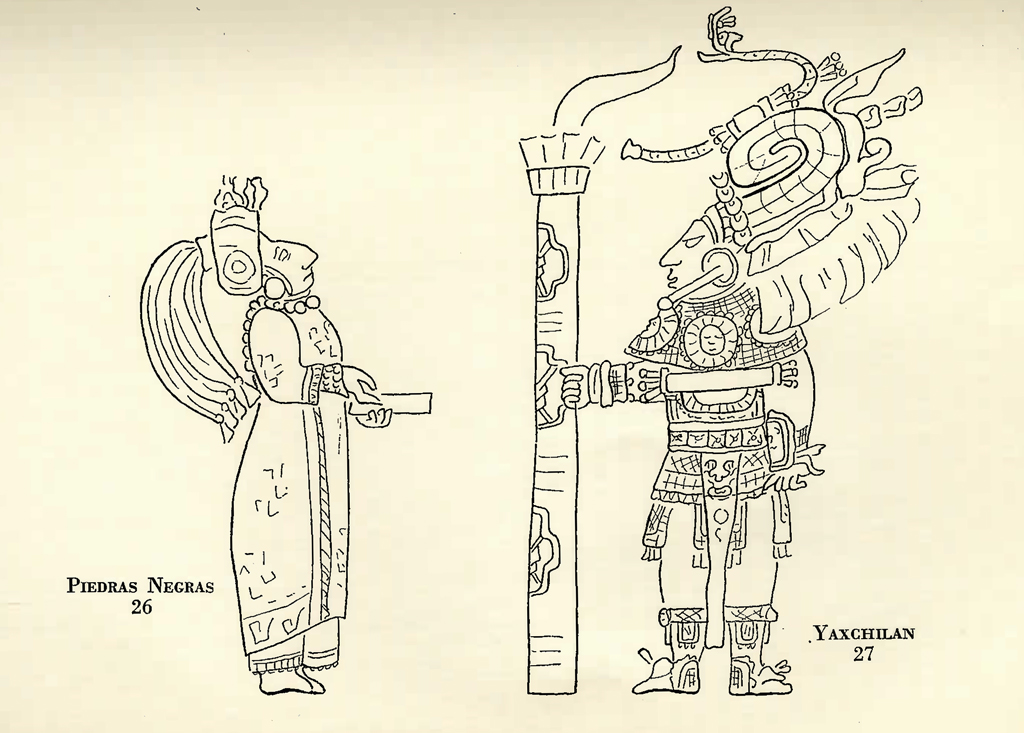
——
This, then, is a written report handicapped by scarcity of available material that even so does offering definite possibilities for throwing light on the vexed question of Maya history. Even negative show is valuable, for information technology can show the states that the variation in costume is local rather than chronological, thereby indicating influences and diffusions from one city to another. If farther finds should show that present apparent differences betwixt costumes of cities of the Old Empire are non-existent, that would at least be a definite proof of cultural uniformity.
Something may be learned of the interrelation of the Old Empire with Yucatan by comparing carvings from the Peninsula with those from the Guatemala cities. The occurence of apparent atlatl darts in the equipment of warriors of the Erstwhile Empire, for instance, will, if substantiated, mean either that Toltec influence was felt in Guatemala long before the days of the Yucatecan league, or else that this weapon, supposedly characteristic of the Nahua people, was early known to the Maya likewise.
The cases of identical costumes on different monuments are so far rare enough to permit the idea that they are actual portraits. If they should prove, however, with more cloth, to be just costumes typical of, perhaps, certain orders of priests or warriors, that, in itself, should help in interpreting what nosotros know of Maya history and social organisation. For this, carvings and paintings that show two or more than persons are more valuable than those with just one, for the interrelation of the figures is often an indication of their respective status.
Study of the gods of the codices, where they can be identified in the archaeological material, may throw new low-cal on their proper nomenclature, for here their costumes seem to be more comprehensive and more suggestive of their divine attributes than those they vesture in the codices.
The possibilities of this line of research are, therefore, varied enough to warrant further investigation.
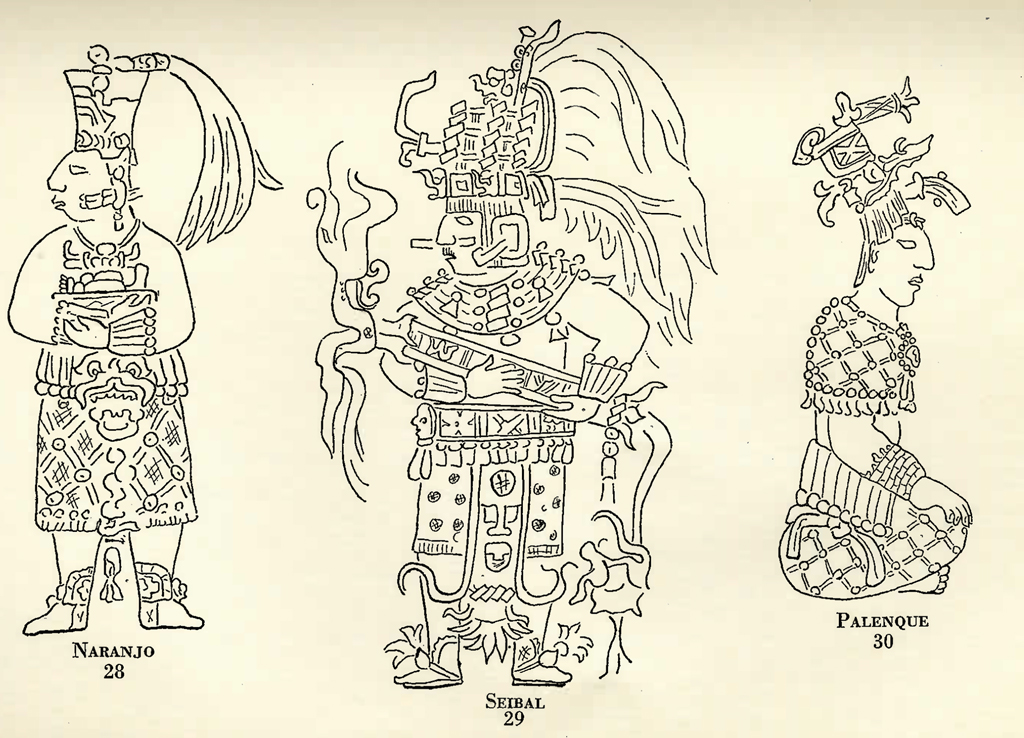
Appendix
Features Each City Has in Common With Each Other City, and, Below, What Those Features Are
| T | C | PN | Y | Northward | Ts | IS | Q | Ck | I | S | P | Py | |
|---|---|---|---|---|---|---|---|---|---|---|---|---|---|
| Tikal | – | 3 | five | 2 | 1 | – | ane | 1 | – | – | – | 4 | 2 |
| Copan | 3 | – | 5 | one | 4 | i | – | 4 | 1 | – | 1 | 4 | 3 |
| Piedras Negras | 5 | v | – | 4 | 4 | 1 | – | 1 | ii | – | – | 3 | i |
| Yaxchilan | 2 | i | 4 | – | 3 | – | one | 1 | – | – | – | 2 | 4 |
| Naranjo | 1 | 4 | 4 | three | – | – | 1 | – | ii | – | – | 2 | iv |
| Tsendales | – | one | one | – | – | – | – | – | – | – | – | 1 | – |
| Itsimte S | 1 | – | – | 1 | one | – | – | one | – | – | – | – | – |
| Quirigua | ane | iv | ane | i | – | – | 1 | – | – | – | – | – | – |
| Cankuen | – | 1 | 2 | – | 2 | – | – | – | – | – | – | 1 | – |
| Ixkun | – | – | – | – | – | – | – | – | – | – | – | – | – |
| Seibal | – | 1 | – | – | – | – | – | – | – | – | – | – | i |
| Palenque | 4 | 4 | three | 2 | 2 | one | – | – | one | – | – | – | – |
| Pottery | 2 | iii | 1 | 4 | 4 | – | – | 1 | – | 1 | – | – | – |
| Copan | Tikal | Round turban, chin strap, back shield. |
|---|---|---|
| Yaxchilan | Dorsum shield. | |
| Naranjo | Brusque feather cape, net cape and long skirt, inflexible necklace. | |
| Quirigua | No skirt, snake jaw chain, elves,* inflexible necklace. | |
| Tsendales | Back shield. | |
| Cankuen | Long net brim, snake snout on shield here | |
| Seibal | Inflexible necklace. | |
| Piedras N. | Copan | Snake snout headdress, curt feather capes, lower jaw headdress, round turban, elves. |
| Tikal | Long feather cape, robes, curt net skirt, circular turban, hinged elbow headdress. | |
| Yaxchilan | Girdle, beads; frock loin cloth, robes, snake tail headdress. | |
| Naranjo | Brusque feather cape, long feather greatcoat, leafage necklace, shell orna¬ment. | |
| Tsendales | Head on staff. | |
| Cankuen | Bead girdle, snake snout on Ck. shield, snake tail headdress. | |
| Quirigua | Elves. | |
| Palenque | Piedras N. | Caput on staff, short internet skirt, apron loin material. |
| Tikal | Brusque net skirt, woven ornament, swinging back figure, mentum strap. | |
| Copan | Long net skirt, net cape, mentum strap, ophidian jaw concatenation. | |
| Yaxchilan | Apron loin cloth, axe. | |
| Naranjo | Long net brim and cape. | |
| Cankuen | Long net skirt. | |
| Tsendales | Head on staff. | |
| Naranjo | Tikal | Openwork spear. |
| Yaxchilan | Fan, basket, tabbed warrior costume. | |
| Cankuen | Javelin, tabbed warrior costume. | |
| Itsimte S | Openwork spear. | |
| Yaxchilan | Tikal | Brusk skin cape, manikin scepter heald by ophidian leg. |
| Quirigua | Itsimte S. manikin scepter held by serpent leg. |
Occurring on old Empire reliefs:
| In four cities. | |
|---|---|
| Internet cape and long skirt | C, N, P, Ck |
| Back shield | T, C, Ts, Y |
| Inflexible necklace | C, Q, N, S |
| Manikin scepter (usual form) | T, Q, Y, Is |
| In 3 cities. | |
|---|---|
| Robes | T, PN, Y |
| Short net skirt | T, PN, P |
| Openwork spear | T, North, IS |
| Circular turban | T, C, PN |
| Chin strap | T, C, P |
| Brusque feather cape | C, PN, N |
| Ophidian jaw chain | C, Q, P |
| Caput on staff | PN, Ts, P |
| Snake tail headdress | PN, Y, Ck |
| Tabbed bead(?) girdle | Y, N, Ck |
| Long feather cape | T, PN, N |
| In 2 cities. | |
|---|---|
| Hinged elbow headdress | T, PN |
| Woven neck ornamentation, swinging back effigy | T, P |
| Pare cape | T, Y |
| No skirt | C, Q |
| Elves, lower jaw snake snout headdress | C, PN |
| Shell ornament, leaf necklace | PN, N |
| Tunics | PN, Y |
| Axe | Y, P |
| Fan, basket | Y, North |
| Javelin | N, Ck |
Whatever object occurring more four times is considered too frequent to be significant.
Probable Dates of Erection of Monuments Cited
Spinden-Morley Correlation
| Tikal | |
|---|---|
| A.D. | |
| Stela 9 | 215 |
| five | 484 |
| T2 eleven | 487 |
| Stela 16 | 503 |
| Altar v | 503 |
| Copan | |
|---|---|
| Stela P | 363 |
| 2 | 388 |
| I | 407 |
| C | 470 |
| A | 471 |
| B | |
| D | 476 |
| N | 501 |
| Chantry L | 502 |
| Step | 503 |
| Altar T | 523 |
| Stela F | 523 |
| H | 524 |
| Stela 11 | 516 or (?)570 |
| Yaxchilan | |
|---|---|
| A. D. | |
| Stela half-dozen | 396 |
| xix | 472 |
| Lintel 9 | 476 |
| xv | |
| 26 | 477 |
| 42 | 480 |
| 14 | 481 |
| Stela 5 | 484 |
| Lintel 46 | 486 |
| 33 | 487 |
| i | 492 |
| 5 | |
| vii | |
| xvi | |
| Stela eleven | |
| xx | 494 |
| Lintel iii | 496 |
| Stela xviii | |
| Lintel ii | 497 |
| 6(?) | |
| 8 | 500 |
| 24 | 501 |
| Stela 1 | |
| Lintel 32 |
| Naranjo | |
|---|---|
| A. D. | |
| Stela 3 | 422 |
| 28 | 431 |
| 20 | 434 |
| 24 | 442 |
| 22 | |
| 21 | 447 |
| 23 | 452 |
| 2 | 453 |
| 29 | 455 |
| 30 | |
| 31 | 462 |
| eighteen | 466 |
| five | 472 or 524 |
| thirteen | 526 |
| 14 | 530 |
| 12 | 540 |
| 6 | |
| xi(?) | 543 |
| viii | |
| 7 | 550 |
| 32 | 560 |
| Tsendales | |
|---|---|
| Stela | 432 |
| Itsimte Sacluk | |
|---|---|
| Stela 1 | 452 |
| Quirigua | |
|---|---|
| Stela H | 491 |
| Altar 50 | 493 |
| Stela F | 501 |
| D | 506 |
| Due east | 511 |
| C | 516 |
| A | |
| Thou | 545 |
| Cankuen | |
|---|---|
| Stela 2 | 530 |
| i | 535 |
| Ixkun | |
|---|---|
| Stela one | 530 |
| La Mar | |
|---|---|
| Stela i | 523 |
| 2 | 545 |
| Seibal | |
|---|---|
| Stela 7 | 540 |
| viii | 590 |
| 9 | |
| 10 | |
| eleven | |
| 1 | 609 |
| 2 | (?) |
Notes
The map is later Morely.
A drawing of the stela at Tsendales will be plant, Figure 232, in Spinden, folio 197.
A drawing of the figure at Xupá, is in Maler, 1901, page 21.
Jades referred to are, unless otherwise stated, in the Peabody Museum, Cambridge, Mass. The Gann jade plaque is figured in Joyce, 1927, folio 171. Figurines are in the University Museum, Philadelphia.
The drawings are from the following sources:
Folio 157
- Gordon, pl. eight
- Maudslay, Iv, pl. 11 (d)
-
- Maudslay, I, pl. 92 (half-dozen)
- Maler, 1901, pl. xiii
- Maler, Ii, p1. 32
-
- Maudslay, II, pl. 84
- Maler, 1901, p1. 31
- Maler, 1903, pl. 38
- Maudslay, IV, pl. 81
Folio 158
-
- Spinden, 1913, fig. 24
- Maudslay, 3, pl. 78
- Maudslay, Iv, pl. 71
- Maler, 1901, pl. 23
- Maudslay, I, pl. 34
Folio 161
-
- Maler, 1908, pl. ix
- Maler, 1911, pl. 28
- Maudslay, II, pl. 92
- Maler, 1901, pl. 14
-
- Spinden, 1913, fig. 1 (b)
- Spinden, 1913, fig. 83
- Maler, 1903, p1. 72
-
- Maudslay, IV, pl. 11 (e)
- Maler, 1903, pl. 49
- Maudslay, II, pl. 36
- Maler, 1908, pl. 20
- Maudslay, II, pl. 25
- Maler, 1901, p1. 21
- Maudslay, 4, pl. 81
- Gordon, p1. thirty
Page 162
- Maler, 1903, pl. 49
- Maudslay, II, pl. 84
- Maudslay, I, pl. 82
-
- Maler, 1903, pl. 74
- Maudslay, 4, pl. 10
-
- Spinden, 1913, fig. 15 (a)
- Maler, 1901, pl. 28
- Maler, 1903, pl. 73
- Maudslay, IV, pl. 36
Page 165
-
- Maler, 1903, pl. 36
- Maudslay, Iv, pl. 76
- Maudslay, IV, pl. 36
-
- Maler, 1908, p1. 23
- Maler, 1901, pl. 17
- Maler, 1901, pl. 23
-
- Maler, 1908, pl. 42
- Maudslay, Iv, pl. 36
- Maler, 1903, pl. l
- Maudslay, I, pl. 82
Folio 166
-
- Spinden, 1913, fig. 47 (a)
- Maudslay, 2, p1. 95
- Spinden, 1913, fig. 50
- Spinden, 1913, fig. 84 (c)
- Spinden, 1913, fig. 103
- Maler, 1911, pl. 26
Folio 169
-
- Maudslay, I, pl. 63
- Maudslay, I, pl. 92
- Maudslay, Two, pl. 36 (b)
Page 171
- Maler, 1901, pl. 20
- Maler, 1903, pl. 63
Page 173
- Maler, 1908, pl. 39
- Maler, 1908, pl. 8
- Maudslay, IV, pl. 10
Bibliography
| Dieseldorff, E. P. | A Pottery Vase with Figure Painting from a Grave in Chamá. Bureau of American Ethnology, Bulletin 28, page 639. |
| A Clay Vessel with a Picture of a Vampire-headed Deity. Bureau of American Ethnology, Bulletin 28, page 665. | |
| Kunst and Religion der Mayavölker. Berlin, 1926. | |
| Förstemann, E. | The Vase of Chamá. Agency of American Ethnology, Bulletin 28, page 647. |
| Gordon, Thousand. B. | A Study of Maya Pottery. Philadelphia, 1925. |
| Joyce, T. A. | Mexican and Maya Fine art. London, 1927. |
| Maler, T. | Explorations in the Department of Peten, Republic of guatemala, and Adjacent Region. Explorations of the Upper Usumatsintla and Side by side Region. Peabody Museum Memoirs, Vol. 4. Cambridge, 1908. |
| Researches in the Key Portion of the Usumatsintla Valley. Peabody Museum Memoirs, Vol. 2. Cambridge, 1901-03. | |
| Explorations in the Department of Peten. Peabody Museum Memoirs, Vol. V. Cambridge, 1911-13. | |
| Maudslay, A. P. | Biologia Centrali-Americana. London, 1899-1902. |
| Seler, E. | The Vase of Chamá. Bureau of American Ethnology, Bulletin 28, page 651. |
| Spinden, H. J. | A Study of Maya Fine art. Peabody Museum Memoirs, Vol. Vi. Cambridge, 1913. |
| Unpublished MS in Peabody Museum on Dates on Maya Monuments |
Source: https://www.penn.museum/sites/journal/9340/
Posted by: jonesobbect1991.blogspot.com

0 Response to "What Do The Belts Decorated With Crocodile Emblems Worn By The Two Kneeling Figures Symbolize?"
Post a Comment